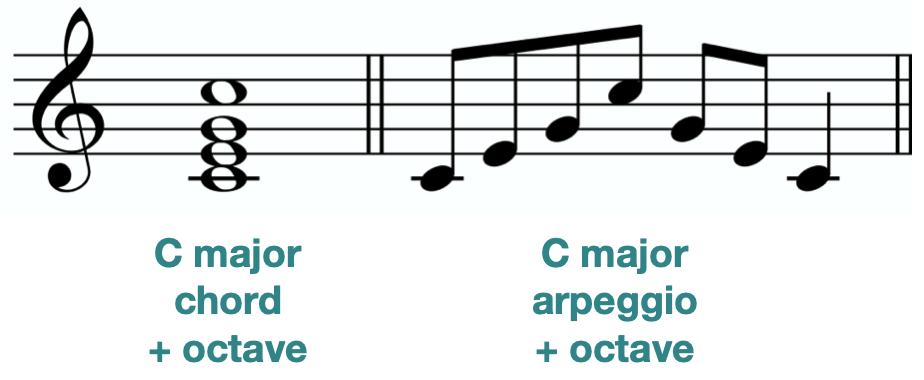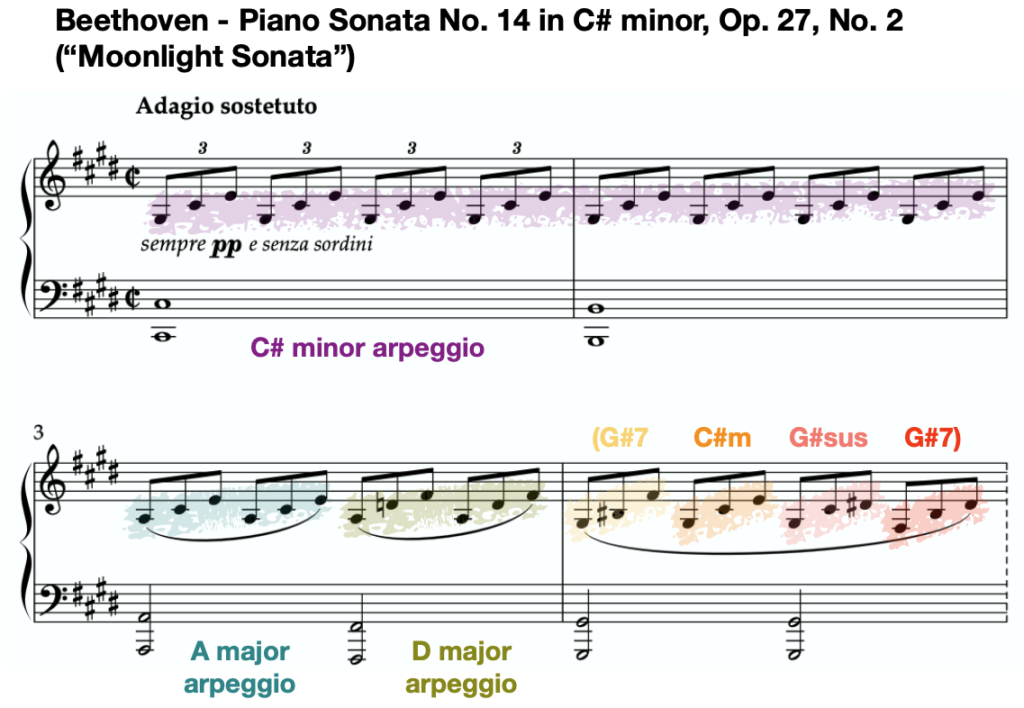
Arpeggios are some of the most common musical figures played at the piano. They are frequently used to give shape and movement to the harmonies in many styles of piano music. Knowing how to play scales, chords, and arpeggios is the core of a pianist’s basic technical skills.
What are Arpeggios?
“Arpa” is the Italian word for “harp,” and the word arpeggio is derived from the Italian term, “arpeggiare,” which means, “to play on a harp.” As with the harp, the piano is an instrument of many notes that are playable by individual fingers. Playing these notes in the configuration of arpeggios comes naturally to both instruments.
The simplest definition of an arpeggio is that it is a chord whose notes are played broken apart instead of together:

Arpeggios can assume different shapes and sizes, but are commonly seen rising and falling:

The most basic arpeggios happen within an octave, and can be played without any crossing. However, in many cases arpeggios extend further, sometimes reaching several octaves in size:


Many famous pieces feature arpeggios prominently in their design:



How to Play Arpeggios
To play an arpeggio at the piano, you first need to find the chord being used to generate its notes.
Let’s find a C major chord. Using your right hand, put your thumb, middle finger, and pinky on a C, E, and G on the keyboard. Remember: we refer to our fingers by number: pinkies are 5, ring fingers are 4, middle fingers are 3, index (pointer) fingers are 2, and thumbs are 1. We’ll use numbers to talk about our fingers from now on.
Find the chord and play it with 1, 3, and 5:

To play the simplest arpeggio, all your need to do is play one note at a time, starting from C, going up to G, and back again:
Try to keep a steady, even pace as you play. Remember to try all of the arpeggios in your left hand as well (do we need left-hand fingerings?).
Single octave arpeggios are often played with the top note of the octave in addition to the chord. To do this, switch your fingering to 1, 2, and 3 on the notes of the C major chord, and put your pinky (5) on the next C up:

Once again, all you need to do now is to play from the bottom C to the top C, and back again:
In the left hand, the finger numbers are 5, 3, 2, and 1 for this arpeggio.
The final arpeggio we’ll look at is a basic crossing arpeggio, covering two octaves.
To play this arpeggio, you’ll need to play the first C major chord with 1, 2, and 3 (as in the chord above), and then cross your thumb under to reach up to the C octave. You can then play the next C major chord + octave top note just like you did above. To come down, you cross your third finger over your thumb on the center C to the G below.
Here is a short video of Liberty Park Music piano instructor West Troiano demonstrating the two-octave arpeggio with the right and left hands by themselves, and then together:
For more on how to play crossing arpeggios, check out this lesson from Liberty Park Music’s Piano Techniques course!
Thanks for checking out this article from Liberty Park Music! If you liked what you saw here, you can find more in our blog at libertyparkmusic.com. We also have a YouTube page! And if you're really ready to take your music training to the next level you can subscribe to our site and gain access to a full spectrum of piano, guitar, drum, and music theory lessons.
Sign up for our free newsletter
Useful articles for musicians
About the Author: West Troiano
West has over 10 years of teaching experience in settings that vary from private studios to college classrooms. In addition to teaching through traditional forms of piano pedagogy, West frequently produces music and teaching materials that cater to the needs of his students. Check out West's course on Piano Etudes for both beginners and intermediate pianists.







